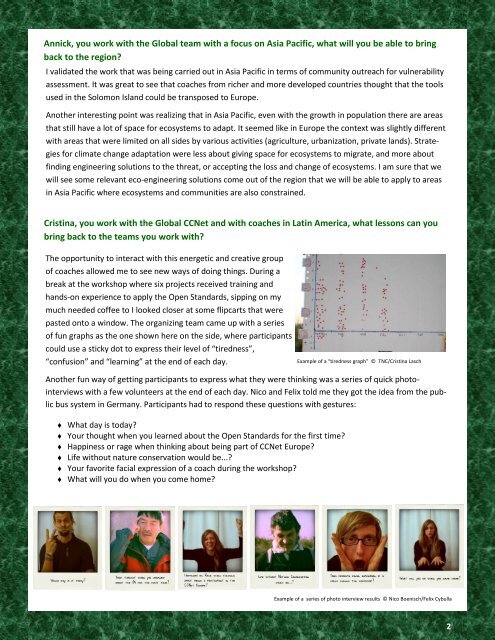download file (751k) - Conservation Gateway
download file (751k) - Conservation Gateway
download file (751k) - Conservation Gateway
You also want an ePaper? Increase the reach of your titles
YUMPU automatically turns print PDFs into web optimized ePapers that Google loves.
Annick, you work with the Global team with a focus on Asia Pacific, what will you be able to bringback to the region?I validated the work that was being carried out in Asia Pacific in terms of community outreach for vulnerabilityassessment. It was great to see that coaches from richer and more developed countries thought that the toolsused in the Solomon Island could be transposed to Europe.Another interesting point was realizing that in Asia Pacific, even with the growth in population there are areasthat still have a lot of space for ecosystems to adapt. It seemed like in Europe the context was slightly differentwith areas that were limited on all sides by various activities (agriculture, urbanization, private lands). Strategiesfor climate change adaptation were less about giving space for ecosystems to migrate, and more aboutfinding engineering solutions to the threat, or accepting the loss and change of ecosystems. I am sure that wewill see some relevant eco-engineering solutions come out of the region that we will be able to apply to areasin Asia Pacific where ecosystems and communities are also constrained.Cristina, you work with the Global CCNet and with coaches in Latin America, what lessons can youbring back to the teams you work with?The opportunity to interact with this energetic and creative groupof coaches allowed me to see new ways of doing things. During abreak at the workshop where six projects received training andhands-on experience to apply the Open Standards, sipping on mymuch needed coffee to I looked closer at some flipcarts that werepasted onto a window. The organizing team came up with a seriesof fun graphs as the one shown here on the side, where participantscould use a sticky dot to express their level of “tiredness”,“confusion” and “learning” at the end of each day.Example of a “tiredness graph” © TNC/Cristina LaschAnother fun way of getting participants to express what they were thinking was a series of quick photointerviewswith a few volunteers at the end of each day. Nico and Felix told me they got the idea from the publicbus system in Germany. Participants had to respond these questions with gestures:What day is today?Your thought when you learned about the Open Standards for the first time?Happiness or rage when thinking about being part of CCNet Europe?Life without nature conservation would be...?Your favorite facial expression of a coach during the workshop?What will you do when you come home?Example of a series of photo interview results © Nico Boenisch/Felix Cybulla22
















